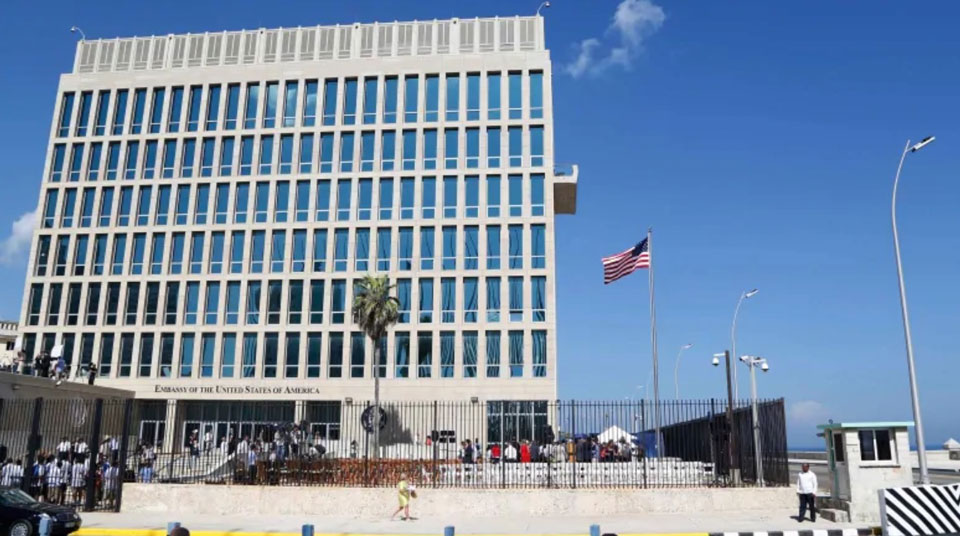
President Obama on December 17, 2014, announced a U.S. opening to Cuba. Months later there was a U.S. embassy in Havana. Beginning in late 2016, however, some diplomats there –CIA agents among them – experienced strange noises, hearing loss, headaches, impaired memory, confused thinking, dizziness, impaired vision and more. Expressing safety concerns, the State Department in September, 2017 recalled most of its employees from its Embassy in Cuba.
No longer was the Embassy able to perform regular functions. Yet in China and Canada, where U.S. diplomats exhibited similar symptoms, U.S. embassies went on with their work. Something else was different: the afflicted U.S. diplomats in Cuba, but not in the two other countries, were judged by the FBI to be “possible victim[s] of a crime.”
Speculation as to what caused the symptoms has ranged from psychiatric illnesses like conversion reaction and mass hysteria to viral infections, chemical agents, microwaves, and confused reactions to sounds produced by a raucous brand of Cuban cricket.
U.S. officials introduced the idea of a “covert sonic device.” They and the media refer to “sonic attacks.” President Trump and Republican Florida Sen. Marco Rubio led in blaming Cuba for leaving the diplomats unprotected, or causing their illnesses, or both.
Ostensibly the U.S. government attended to the stricken diplomats out of solicitude for their welfare. But increasingly officials looked like they were exploiting the illnesses to exert pressure on Cuba’s government. To know what caused the symptoms would help clarify the situation, surely. The same goes with insight into how immobilization of the Havana embassy fits with systematic U.S. attempts to destroy Cuba’s revolution.
A team of neuroscience specialists associated with the University of Pennsylvania and hired by the U.S. government has evaluated the diplomats sickened in Cuba and China. Identification of disease processes or injuries might account for their symptoms.
A report on assessments of 40 embassy employees in Cuba appeared in the Journal of the American Medical Association (JAMA) on July 25, 2019. JAMA had published a report on 21 of them in March, 2018. This time the specialists compared findings on the patients with study results on 48 healthy control subjects. The diplomats being assessed included all but one of those studied earlier. This time the specialists used “advanced magnetic resonance imaging” as their principal investigatory tool.
They identified significant abnormalities in the diplomats’ brains, including a reduced volume of white matter and “impaired connectivity between neurons in the auditory and visuospatial subnetworks of the brain.” (The term “white matter” signifies parts of the brain populated by nerve fibers, not by nerve cells.)
Even so, they were unable to establish a cause or causes for the symptoms. They indicated that, “The clinical importance of these differences is uncertain,” also that, “The underlying neuroanatomical findings have not [previously] been described.” Their report uses the term “uncharacterized directional phenomena” rather than “sonic attacks.”
Commenting on the study, prominent U.S. neuroscientist R. Douglas Fields suggests that the imaging used in the recent study is a research tool: “These are not medical imaging methods—they’re not diagnostic …They don’t show pathology.”
Interviewed on a Cuban website, Dr. Mitchell Joseph Valdés-Sosa, director of the Cuban Neuroscience Center, indicated that, “The changes described are small, varied, and diffuse and don’t correspond to a coherent picture.” And, “unique effects showing up in small samples can originate by chance.”
Selection of the control group was problematic: “Differences evident in the imaging could have resulted from preexisting illnesses among the diplomats not present in the control subjects, and visa versa.” In this regard, “12 of those affected had pre-existing histories of concussion, compared to none in the healthy controls,” according to another critic.
The Cuban expert found no correlation between alterations shown in the imaging and the diplomats’ symptoms and no connection between the findings of the two Pennsylvania studies.
U.S. political purposes now intrude. Reflecting such, the dominant media embellished reports on the recent JAMA report with hyperbole. “US diplomats’ brains were shrunk,” claimed one UK newspaper. They were “left paralyzed,” declared another. “Cuba ‘sonic attacks’ changed US diplomats’ brains,” the New York Post reported.
A dysfunctional U.S. embassy has aggravated Cubans. Now to obtain visas for travel to the United States they must travel to U.S. embassies elsewhere, at great cost and great inconvenience. Visits to family members in the United States are now mostly impossible, as is legal emigration there.
What with sharply reduced access to consular services, potential U.S. visitors to Cuba may fear having to deal with personal emergencies there. In line with U.S. intentions, they may prefer to stay home. And U.S.–Cuban negotiations on a variety of issues that began in the Obama era are stalled, due in part to troubles at the embassy.
Shortly after recalling diplomats from Havana, the U.S. government expelled 15 Cuban diplomats from Washington, supposedly as a matter of “equity” in matching reduced U.S. embassy personnel. Really, of course, that display of arbitrariness and rancor epitomizes the counter-revolutionary motivations of U.S. leaders. That’s the larger context of actions taken to exploit the diplomats’ illnesses.
U.S. efforts to abandon diplomatic institutions and diplomats having to do with Cuba – they epitomize normal bi-national relations – is consistent with the major thrust of U.S. anti-Cuban policies, that of depriving the Cuban people of money, supplies, and services. Disabling the embassy thus joins implementation of Title III of the 1996 Helms-Burton Law (to interfere with foreign investments) and new restrictions on U.S. travel and spending in Cuba in a renewed assault on the Cuban revolution.










